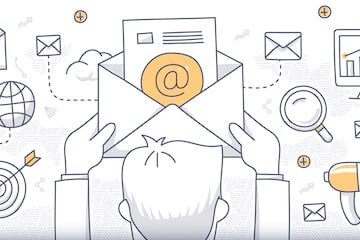Ecommerce marketers eager for a competitive advantage can monitor competitors’ email campaigns for insights and opportunities.
Most new businesses focus initially on advertising and search engine optimization. Eventually competitive monitoring often emerges, becoming part of a standard marketing toolbox.
Email-tracking providers include Hoppy Copy, SendView, Owletter, and MailCharts. These and others parse, analyze, and store competitive email data.
But thanks to artificial intelligence, businesses can track competitors’ email marketing with little more than the Zapier email parser and ChatGPT, in five steps:
- Use a Gmail address to sign up for competitors’ emails.
- Automatically forward the ensuing Gmail messages to the Zapier email parser.
- Use ChatGPT to pull relevant data from the parsed email message.
- Load the data into a Google Doc, Airtable, or similar.
- View the data in a business intelligence dashboard such as Looker.
Sign up several times for each competitor’s mailing list to receive segmented messages.

AI makes tracking competitors’ email marketing relatively inexpensive.
What to Track
Competitive tracking is often two-pronged: current activity (insights) and omissions (opportunities). For insights, look for marketing and operational behavior, such as:
- Audience segments and personalization. This is why you subscribed several times. Does the competitor send different messages to segments?
- Email timing and frequency. Discover the time or day a competitor broadcasts a message. Do content emails have a cadence? What about promotional offers?
- Email sequences and behavioral triggers. Analyze email sequences, such as a welcome series, cart abandonment, or post-purchase. What are the triggers? How long is the series? What is the content?
- Subject lines and preview text. Review email subject lines and preview text. Do competitors A/B test subject lines (another reason to sign up more than once)? Is there a pattern to subject lines?
- Content marketing. Do competitors use email to promote content? Is there an editorial newsletter? Or do promotional messages have a content section?
- Deliverability. Do competitors’ messages arrive in the inbox or the promotional tab? What content impacts deliverability?
- Email technology. What email service providers do competitors use? Are they employing other third-party tools? Can you detect AI-generated content?
- Promotional structure and reuse. Do competitors have standard email offers, such as buy-one-get-one or percentage off? Are discounts product-specific or storewide? Are offers repeated?
In each case, monitor aspects of messages that could improve your own email program. Look also for opportunities, such as:
- Promotional propositions and placement. Analyze strengths and weaknesses of competitors’ promotional messages. Could you deploy better versions or similar?
- Customer experience. Do competitors engage shoppers? What tactics can you replicate or initiate?
- Content strategy and gaps. Identify competitors’ content gaps that could help your business.
- Product gaps. Look for missing upsells or resales in transactional messages or post-purchase sequences.
Successful Strategies
Ecommerce can be fiercely competitive. AI has made email monitoring easy and relatively inexpensive — even small businesses can benefit.




